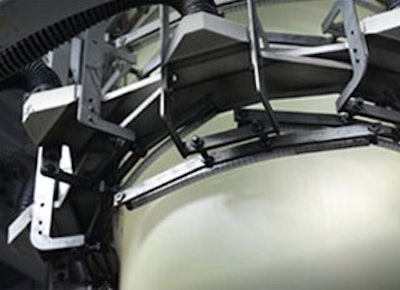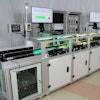
Techniques for selecting and applying non-contact temperature measurement instruments for use in the plastics industry involve several factors. One is the spectral emission characteristics of the plastic to be measured. Others are the optical performance, required elimination of interference sources, environmental parameters, and control interface requirements. It is most effective to design an installation which results in using the highest emissivity value possible. The spectral response of the instrument should thus be matched to the type of plastic to be measured.
Plastic Infrared Emission Characteristics
Infrared thermometers calculate plastic temperatures by detecting emitted energy from the plastic, then processing the resulting electronic signal. A major factor in this process is emissivity (ε) a measure of an object's effectiveness in radiating thermal energy. However, spurious energy can come from radiation transmitted from a hotter object behind it, or reflected from a hotter object in front of it.
The energy emitted by a plastic is not evenly distributed. By observing the wavelengths at which peak energy is emitted, an instrument sensitive to that wavelength can be selected. This selection is most critical for thin-film plastics, since they tend to be transparent at many wavelengths. For example, polyethylene is partially transparent (about 75 percent or t = 0.75) at most wavelengths between 2 and 16 microns except for a few wavelengths at which strong absorption bands exist. An absorption band at about 3.4 microns causes transmission to be zero, so 25-micron thick polyethylene is opaque at this wavelength. Since most plastics have reflectance (r), of about 0.04, emissivity can be calculated for polyethylene at 3.4 microns as follows: ε = 1 - r - t = 1 -0.04 -0 = 0.96.
An instrument with a spectral response of 3.4 microns is the best choice to measure temperature of thin polyethylene films. Since t decreases and emissivity increases as thickness increases, spectral response becomes less important with thicker plastics. Pigmentation also reduces transmission and improves the emissivity of thin films. In general, thickness of less than 2.5 millimeters requires consideration of spectral emission, which should be analyzed with a spectrophotometer to determine the best wavelengths for non-contact temperature measurement.
In general, two spectral response narrow-bands, 3.4 microns and 7.9 microns, are best for measuring thin films. Some thin films can be measured only at 3.4 microns; some can only be measured at 7.9 microns, while others can be measured at either wavelength.
Pyrodynamics instruments with a 3.4 microns filter can be used to measure thin films of polyethylene. Instruments with a spectral response at 7.9 microns are used to measure Teflon and other thin films. Plastics thicker than 2.5 millimeters can also be measured accurately using general-purpose 8 to 14 microns instruments.
These infrared pyrometers offer the advantage of lower cost, broader temperature range, and better availability compared to narrow band instruments.























